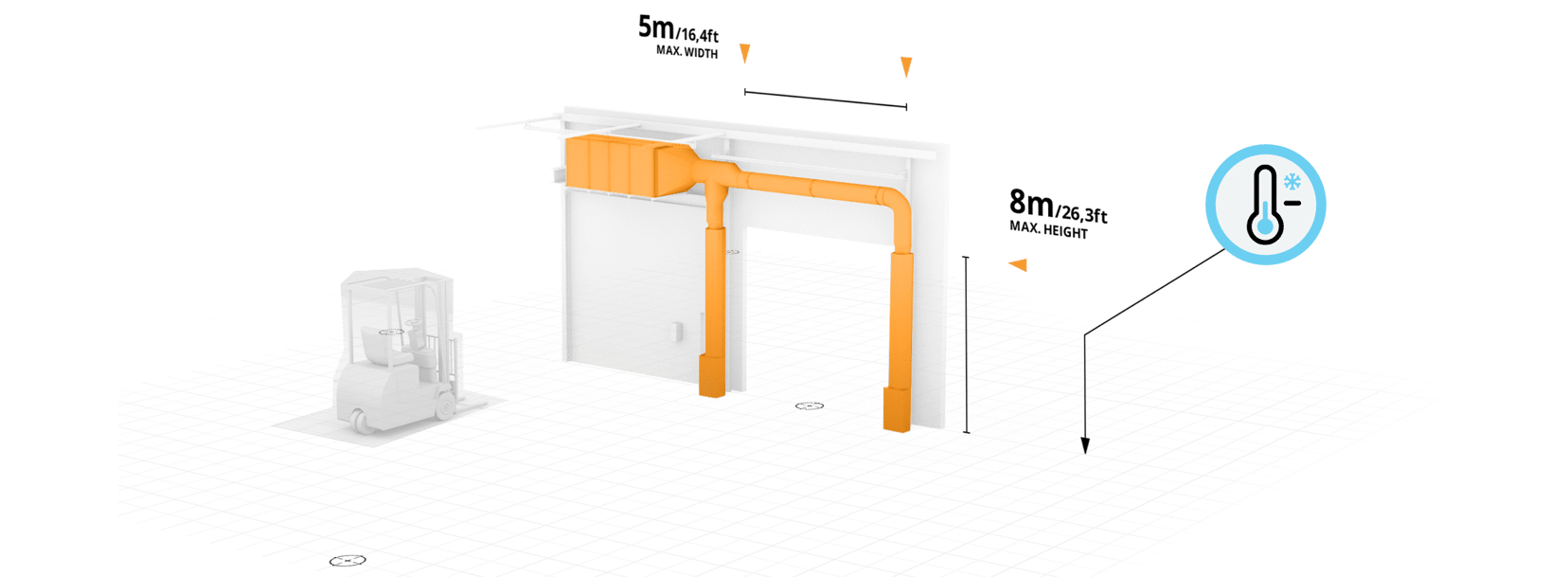
Airwalls increase efficiency of cold insulation
Air-conditioning is energy-intensive: according to the U.S. Energy Information Administration, about 10 percent of the total electricity consumption in the US is used for cooling. In addition to the high electricity consumption, doors and gates are often left open for the expensively cooled air.
Depending on the operation, however, entrances cannot remain permanently closed. Employees have to get to other parts of the production facility, trucks are unloaded and process cooling has to be available all year round. So how do you separate cooled indoor air from warm outdoor air? With a precise barrier of air.
Why cold insulation is important
Heat and warmth can become decisive cost factor: Excessively high working temperatures stress employees, can impair the service life of machines and air-conditioning systems have to work under load to counteract. Building service operating costs rise as a result, while the actual cooling effect evaporates. Refrigeration causes about ten per cent of global CO2 emissions.
So keeping warm air outside by cold insulation is not only advisable for reducing operating costs, it also helps achieve sustainability goals.
More efficient air conditioning and cooling systems are only one key to success. Likewise, consistent insulation is essential to maintain the desired room temperature. However, even the best insulation is of little help if doors or gates have to be open due to ongoing operations, causing cooled air to heat up.
Airwalls: a custom-fit solution for every passageway
There are several ways to insulate against cold. Often, plastic strip curtains are used to reduce an outflow of cool air to the outside. While the curtains are a cost-effective solution, the bulky plastic pieces are often in the way, difficult for vehicles to pass and fundamentally inefficient at sealing.
Airwalls offer custom-fit solutions for every door and gate. Our systems accelerate air and can thus precisely separate layers of air from each other. The airwall keeps cooled air in the building, but at the same time allows unhindered passage of employees and vehicles. Optionally, our airwalls can also be equipped with cooling coils so that they themselves become an integral part of a cooling concept. Even trucks with refrigerated boxes can be effectively protected against heat with our Airwall Move.
Read our casebooks to find out how versatile our technologies are.

Learn more in our casebooks
- Energy efficiency
- Occupational safety
What our airwalls can do:
- reduce energy consumption
- keep heat in the places where it is needed
- seal access points without making them impassable for employees
- increase well-being in the workplace
- can themselves become part of the heating system with heating registers
Our multiple air wall has been reliably sealing the loading ramps of our seven gates against the heat for years, especially in summer. A good solution for our "cool" products!
Do you have any questions?
We will be happy to advise you!
FAQ
Airwalls are systems that accelerate air to high speeds with the help of fans and compress it into a thin jet via a patented nozzle (pressure linear module). The generated air jet prevents layers of air from mixing. Our units can be mounted on the side of gates or above doors. The air jet then separates the air over the entire height. This keeps cold air outside in winter, for example, and does not cool the air indoors. Airwalls are modular and therefore have a lot of planning freedom. They can therefore also be retrofitted without any problems.
Air curtains have a lower air velocity and need a large volume of air to function. As a result, air curtains do not separate different layers of air, but mix them. As a result, if they are used to keep warm air indoors, for example, they need much more energy because they have to heat more air and the heated air mixes directly with the cold outside air. Our systems, on the other hand, work with a small volume of air at high speed and can thus reliably keep air milieus apart. This makes airwalls more energy-efficient and helps companies achieve climate protection goals.
Our Airwall Compact can be installed by customers themselves. For larger installations like our Airwall Grand, we work together with customers to plan the project, manage the installation and control the result. We work together with long-standing partners who take care of the optimal installation with a lot of expertise and enthusiasm. All planning steps are transparent and discussed with customers. Depending on the size and other general conditions, however, the installation can take different lengths of time.
Since airwalls reduce energy consumption in the long term, an investment usually pays off after a short time. The payback depends on the type of use, the size of the doors and the building, as well as energy prices. The mix of energy sources for electricity also plays a decisive role. However, most of our air walls pay for themselves very quickly. They are beneficial for the climate from the very first minute.

